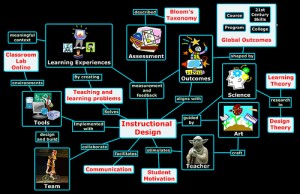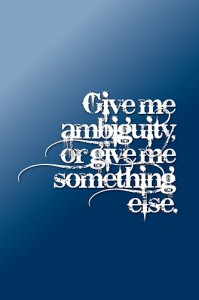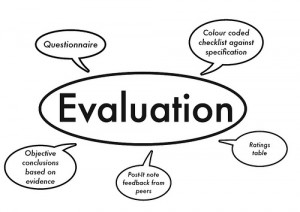Nearly a year ago I posted an old conference paper on necessary skills of instructional designers (How to identify an expert). Here’s another short one* on the same theme from my dim and distant past, which I boldly believe remains relevant. The paper continues the focus on necessary skills for instructional designers. I again applied the wisdom of James G. March, this time by explaining why instructional designers needed to be able to cope (and thrive) in situations involving ambiguity and the formation of coalitions.
Introduction
 In a paper presented at the last ICDE conference (Murphy, 1988), I argued that an instructional designer in distance education (or one working in other modes, for that matter) needs certain analytical skills in order to function effectively. The skill that was discussed there was the analysis of expertise, wherein the designer could use the techniques of interrogation and confrontation (in mild forms, of course) to assess expert knowledge.
In a paper presented at the last ICDE conference (Murphy, 1988), I argued that an instructional designer in distance education (or one working in other modes, for that matter) needs certain analytical skills in order to function effectively. The skill that was discussed there was the analysis of expertise, wherein the designer could use the techniques of interrogation and confrontation (in mild forms, of course) to assess expert knowledge.
This paper introduces two further analytical skills required of the successful instructional designer: the analysis of ambiguity, and the analysis of coalitions (March, 1974). In doing this, the aim is to justify and illustrate the need for such skills, rather than to give detailed prescriptions of how the skills are developed and applied.
The Analysis of Ambiguity
The first skill to be discussed is the analysis of ambiguity. In other words, I believe that designers need to know how to work comfortably and make sound educational decisions and recommendations under ambiguous and uncertain conditions.
 Why should this be important? To my mind, instructional designers work in contexts of greater ambiguity than most other professionals, even other educators. Can this opinion be justified? First, in the wider sense, ambiguity exists within distance education. Such questions as “What is distance education?” and “Is distance education a discipline?” are currently the subjects of debate amongst distance educators (Rumble, 1989; Coldeway, 1989), and, along with other related questions, have yet to be resolved.
Why should this be important? To my mind, instructional designers work in contexts of greater ambiguity than most other professionals, even other educators. Can this opinion be justified? First, in the wider sense, ambiguity exists within distance education. Such questions as “What is distance education?” and “Is distance education a discipline?” are currently the subjects of debate amongst distance educators (Rumble, 1989; Coldeway, 1989), and, along with other related questions, have yet to be resolved.
Further, distance education institutions are rather ambiguous places, often rather unsure of their goals and their technologies. Recent critical scrutiny of the British Open University (Harris, 1987) has revealed the kinds of uncertainties and contrasts between stated ideology and current realities that might be suspected in institutions of lesser stature.
Instructional design itself is a somewhat ambiguous and uncertain discipline (?), despite the existence of valiant attempts to define it and to develop useful prescriptive models and theories (Reigeluth, 1983; Richey, 1986). As well, instructional design still gets mixed up with other
terms such as instructional science, instructional technology, education technology, program development, and so on (Osguthorpe and Zhou, 1989).
Then we come to instructional designers themselves, and here uncertainty abounds. Is the job of an instructional designer that of a transformer (Waller, 1977), a student advocate (Mahoney, 1988), an ‘amicable guerilla’ (Carl, 1989), or one of the other guises to which they have laid claim over the years? Further confusion can be found by looking at the bookshelves in designers’ offices-my experience is that most of them (myself included) have collections of texts the majority of which are from their original discipline (yes, most had lives before instructional design), whether it be mathematics, geography, or psychology. In fact, they are not even sure that they should be called instructional designers, as is evidenced by the increasing use of the term ‘educational developer,’ especially within distance education.
How, then, can designers be helped to work effectively under such ambiguous conditions? First, there needs to be a recognition, especially by instructional designers themselves, of this ambiguity and the uncertainty of their roles. One recent comment on the role has been provided by Abed (1989), and although the description was written for visual designers, I believe it to be equally valid for instructional designers.
The designer’s role is often misconstrued as simple if one merely follows the guidelines. However, this attitude assumes that the designer is a specialist, when in fact he or she is a generalist. Of course, designers vary in their abilities and talents, but a good designer will have a vast body of knowledge and experience upon which to draw to help in decision-making during a project. It is this accumulated experience and exposure to a wide variety of fields on which the designer relies rather than a formulaic approach to decision-making.
Acceptance of the central role of ambiguity in their working lives can then lead designers to adopt new approaches to their tasks. For example, the working relationships between designers and others would be seen in a new light. No longer would they labor under the myth that the academics with whom they work are merely content experts whose teaching skills and experience are of no worth in preparing distance teaching materials. Rather, the relationship is viewed as a collaborative and collegial partnership, so that there is a shared responsibility for and ownership of the instructional design (Jackling, 1989). In this way, the neat separation of roles of designer, academic, editor, graphic designer, and so on is unacceptable, as each person is able to input to all facets of the development work, but with different emphases and skills.
A different attitude to planning can also prevail. Flexibility and readiness to change become the key, with plans being viewed more as interpretations of the past than as guides for future decisions. Designers often work in environments where creativity and the development of new objectives can be hampered by rigid planning.
An associated area that can be approached differently under ambiguous conditions is evaluation. An instructional designer need not specify all the criteria for evaluation during the planning stage. Rather, the relative importance of the criteria will change as plans are implemented, and new criteria will emerge as a project unfolds. This was well put by March (1974) when he said that the evaluation of projects:
… need not be in terms of the degree to which they have fulfilled our a priori expectations. Rather we can examine what they did in terms of what we now believe to be important. The prior specification of criteria and the prior specification of evaluation procedures that depend on such criteria are common presumptions that restrict the serendipitous discovery of new criteria.
Modified viewpoints of other aspects of the role of instructional designer would also be in evidence when ambiguity becomes accepted and skills in coping with it are adopted. Experience, intuition, and values (Meacham, 1989), for example, become more important, and less reliance is placed on rationality and consistency.
The Analysis of Coalitions
Another required skill is in the analysis of coalitions, which can also be called the management of conflict. The word management is used deliberately, in recognition of the notion that conflict has both functional and dysfunctional forms. That is, the aim is not to eliminate conflict, but to control it and use it creatively. Properly controlled, it has the potential for growth and development, and this positive force can be put to good use by a designer who has the skill of coalition-building.
It is very rare for instructional designers to work alone. Most often, they work with and depend upon the skills of other professionals who come to course development with a variety of agenda and resources. This will even be true for academics from the same institution writing materials in the same discipline. Research at the British Open University (Riley, 1984) on course production within teams has revealed the process as complex, individual, and emotional.
Further, in commenting on the results of research by outside consultants, Riley revealed that the
… educational technologist most closely associated with the Lawrence and Young research has since been welcomed as a consultant on conflicts and stress to course teams and to individual team members (Riley, 1984).
It seems that, in this case, an instructional designer with skills in the analysis of coalitions has not only been needed, but has also been valued by the staff involved in the process.
Skills in coalition-building can be learned, once the need for them is accepted, and an appropriate perspective on conflict management is developed. One relatively mechanistic perspective is explained by March (1974) as follows:
We assume that any decision can be made if there is enough support for it… In order to secure support, various trades are undertaken. A policy proposal is modified to include (or exclude) items of concern to key potential supporters; agreements are made to trade support on future issues for trades on current issues; arrangements are made to encourage third party intervention. A market in political horse-trading is established; an omnibus policy is developed.
Though we may feel uncomfortable about some aspects of this perspective (or even all of it), it illustrates one way that agreement can be reached in situations of conflict. Modified versions of such a perspective may be required to enable a course development team to overcome disagreement among members. Whatever perspective is adopted, the aim of conflict management is the promotion of win-win outcomes (not always equal winners, of course), rather than win-lose situations.
To introduce a final note of confusion to this section, it also needs mentioning that agreement can be just as dysfunctional as conflict. Just because people are working harmoniously does not mean that they are operating productively.
So, in the process of coalition-building, the instructional designer has to tread a fine line. The participative decision making that exists in a course team is not only a slow and inefficient process, but can also lead to rampant conflict.  On the other hand, “too much cohesiveness can be just as dangerous as conflict” (Hoy and Miskel, 1987). Cohesiveness leads to uniformity that can produce uncritical likemindedness. In extreme cases this culminates in ‘groupthink’ (Janis, 1971), a condition responsible for such disasters as the infamous Bay of Pigs episode. No designer wants to be a part of an equivalent distance education fiasco.
On the other hand, “too much cohesiveness can be just as dangerous as conflict” (Hoy and Miskel, 1987). Cohesiveness leads to uniformity that can produce uncritical likemindedness. In extreme cases this culminates in ‘groupthink’ (Janis, 1971), a condition responsible for such disasters as the infamous Bay of Pigs episode. No designer wants to be a part of an equivalent distance education fiasco.
Conclusion
Instructional designers, especially in distance education, are currently undergoing something of an identity crisis. Whether or not they survive as a species will depend on their ability to resolve this crisis and, most importantly, develop the skills that are useful to and welcomed by others
involved in the course production process. The skills that have been introduced here are, I believe, necessary abilities for an effective instructional designer.
*Murphy, D. (1990) Further analytical skills for instructional designers. Distance Education: Development and Access. Croft, M., Mugridge, I., Daniel, J.S. and Hershfield, A. (Eds.). ICDE, Caracas, Venezuela.
photo credit: Rich_James via photopin cc
photo credit: Brett Jordan via photopin cc
photo credit: Jordanhill School D&T Dept via photopin cc
photo credit: Queen Roly via photopin cc

Hello David,
It has been a quite while, since we had lunch at Melbourne. How are you? And how are Merylin and her beloved cat doing?
I would like to discuss something with you. Nothing serious. It is about my paper, so would you drop me a line to my gmail. I only have your mou email address, so am leaving a note here.
Yes, I do believe that this paper still holds its validity. You write bloody well. hahaha,
Hope to hear from you soon.
Namin from Seoul
Eat a Dog
Don’t touch my log
flake a smog
And mostly
importantly im on smoko
So leave me alone